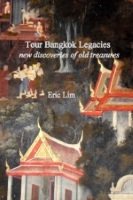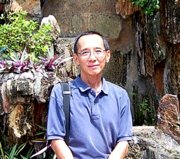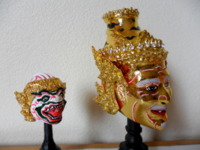- Home
- Bangkok Communities
- Khon Mask Makers
Khon mask makers
the vanishing
community
By Eric Lim
The Khon mask makers in the Saphan Mai community is located in Soi Prachachuen 18, a quiet street with mix of high-rise apartments and old houses in the outskirts of Bangkok.
This community of mask makers wasn't easy to find. I was to realize why later.
After several enquiries, I managed to locate one of the few surviving members of the community, Khun Prathip Rodphai living in a house at the end of the soi.
Khun Prathip makes headpieces for the Khon dance.
The classical Khon dance is based on the Thai Ramakien drama adapted from the Hindu Ramayana epic written by the Sanskrit poet Valmiki. Dancers wear colorful masks or headpieces with elaborate costumes to perform the drama.
Ramayana or the march of Rama depicts the tale of the eternal struggle between good and evil. Prince Rama's beautiful wife Sita is abducted by the evil demon ruler of the island kingdom of Langka, city of the Demons.
Prince Rama goes in search of his wife, seeks help from the monkey king Hanuman and his army of monkeys, storms the demon city and rescues his wife.
Over lunch, Khun Prathip described how to make the Khon masks, the headpiece for the Khon dance. Papier mache is pasted over a clay or plaster mold to create the basic frame for the headpiece. Several layers are stuck on and dried in the sun. The process is repeated.
Plaster or flour is used to harden the mask which is cut in half and removed from the mold. The two halves are stitched together and the stitch marks pasted over. Various designs are added on and the masks are painted with different colors to depict the characters in the Khon dance.
A wide range of headpieces is required for the characters in the drama. Masks for the forces of good are made with elaborate crowns; masks for the villains are bald with fearsome tusks.
Owing to the long process, Khon mask makers usually make several masks made at a time with each at various stages of completion. The completed masks are sold to tourist shops and dance troupes performing in theaters.
According to Khun Prathip, the former Saphan Mai community was much larger before, living in the slum area along the soi. With the construction of modern apartments, many of the slum dwellers have been evicted or relocated.
He is one of few Khon mask makers in the area.
It's sad to see a community of skilled artisans gradually vanishing as modern development takes its toll.
Surely there's room for coexistence?
As for Khun Prathip, he will persevere as it's his profession, one of the few left in a dying breed of Khon mask makers. To appreciate the intricacies in the art of these masters, please see Khon mask maker in Bang Plad who is still practicing and teaching his skills.
To return to Bangkok Communities and for other Traditional Thai art.
Tour Bangkok Legacies – my first e-bookIf you are an independent traveller, here's a handy e-guide book, Tour Bangkok Legacies, which will help you along as you explore the streets of Bangkok and discover its old treasures. It's complete with historical descriptions, maps and detailed directions on how to get to these places.
My Kindle e-book




